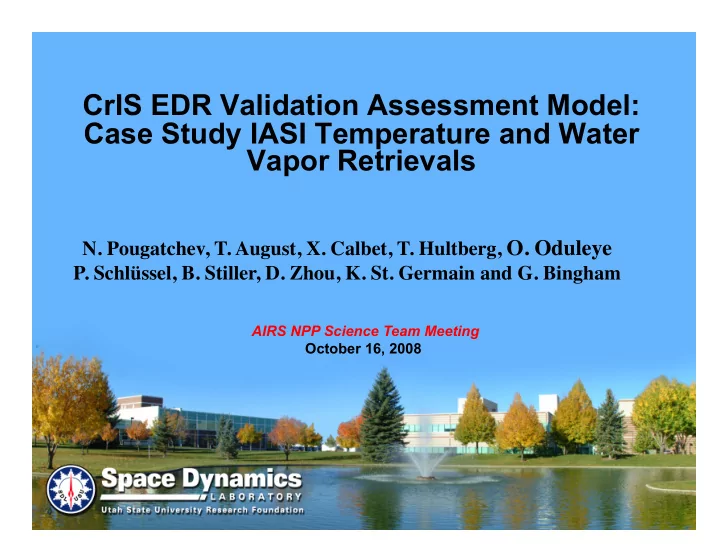

CrIS EDR Validation Assessment Model: Case Study IASI Temperature and Water Vapor Retrievals N. Pougatchev, T. August, X. Calbet, T. Hultberg, O. Oduleye P. Schlüssel, B. Stiller, D. Zhou, K. St. Germain and G. Bingham AIRS NPP Science Team Meeting October 16, 2008
Objectives Methodology for assessment of the Temperature and Water Vapor retrieval errors in the form that can be utilized by the users community – Regionally and Seasonally specific Covariance matrix and Bias Validation of the L2 IASI EUMETSAT retrievals against radiosondes Comparison of EUMETSAT and NASA (Dan Zhou) retrievals – JAIVEx campaign case study
Validation by Correlative Measurements C. D Rodgers, 2001 “Inverse Methods for Atmospheric Sounding, Theory and Practice’ Validated Sounder True State x sat Validation Output Validation Model True State Correlative Measurements x cor N. S. Pougatchev, App. Opt., v. 47, 2008 “Validation of Atmospheric Sounders by Correlative Measurements”
Validation Issues Why do We Need Validation Model Why We Can NOT Use Correlative Data As Is • Characteristic Difference– validated sounder and correlative measurements sample atmosphere differently. • State Non-Coincidence – correlative measurements are at different time and location. Validation Model reconciles the issues by modeling best linear estimate of the satellite measurements and assessing the errors “Validation of Atmospheric Sounders by Correlative Measurements” N. S. Pougatchev, App. Opt., v. 47, 2008
IASI Validation Study • Validation Data Set – radiosondes at Lindenberg (Germany, 52.21 o N, 14.12 o E, 112 m a.s.l ). Dedicated launches 1 hour prior and at the overpass time; and synoptic times (0, 12, 6, and 18 UTC) • Validated parameters – Atmospheric Temperature and Water Vapor Vertical Profiles. • Validated System – IASI characterized by averaging kernels. • Validated Data Set – EUMETSAT v. 4.3 retrievals; cloud clear; 100 km around Lindenberg
Averaging Kernels – Vertical Resolution Temperature and Water Vapor
Temporal Non-Coincidence
Spatial Non-coincidence and Noise
Retrieval Noise and Spatial Non-coincidence Error
Temperature Errors
Relative Humidity Errors
Intermission • The results provide specific error covariance matrix and demonstrate that the averaging kernels represent the retrievals adequately. • That allows one to decontaminate the retrievals from a priori contribution. • The above mentioned factors make the retrievals usable for quantitative use, e. g. for NWP and assimilation.
JAIVEx April 29, 2007, 15:45 h
JAIVEx Temperature
JAIVEx Relative Humidity
IASI (15:48 UTC) vs. AIRS (19:30 UTC) JAIVEx IASI Retrieval Temp Deviation from the Mean (K) Relative Humidity (%) AIRS Retrieval Interpolated to IASI FOV Temp Deviation from the Mean (K) Relative Humidity (%)
Conclusion Methodological • For the assessment of the actual performance of the sounders of the AIRS, IASI and CrIS class the validation approach based on statistical accounting for temporal and spatial non-coincidence and vertical sampling/resolution through averaging kernel formalism is needed. • Radiosondes are good reference source for validation, provided the site has representative geophysical characterization. • Additional work is needed to better characterize true water vapor field and its variation. Combination of techniques other than radiosondes, e. g. high accuracy airborne sounders (NAST-I) with drop-sondes, are needed for accurate WV retrieval error assessment.
Conclusion IASI EUMETSAT Lindenberg Campaign • Under the clear sky condition IASI L2 Temperature and Water Vapor profile retrievals perform at the expected level. That means that the forward model and averaging kernels are accurate. Hence, we know accurately how the true state of the atmosphere translates into the retrievals. • The retrieval and error assessment/validation were made consistently on the same basis. That facilitates the quantitative use of the of the L2 data products.
Conclusion JAIVEx campaign • NASA’s (Dan Zhou) and EUMETSAT retrieval techniques agree within retrieval error. Some discrepancy is observed below 800 mb for both Temperature and Water Vapor retrievals. • Small sample size makes statistical comparison of the retrievals with drop-sondes inconclusive.
THE END
Recommend
More recommend